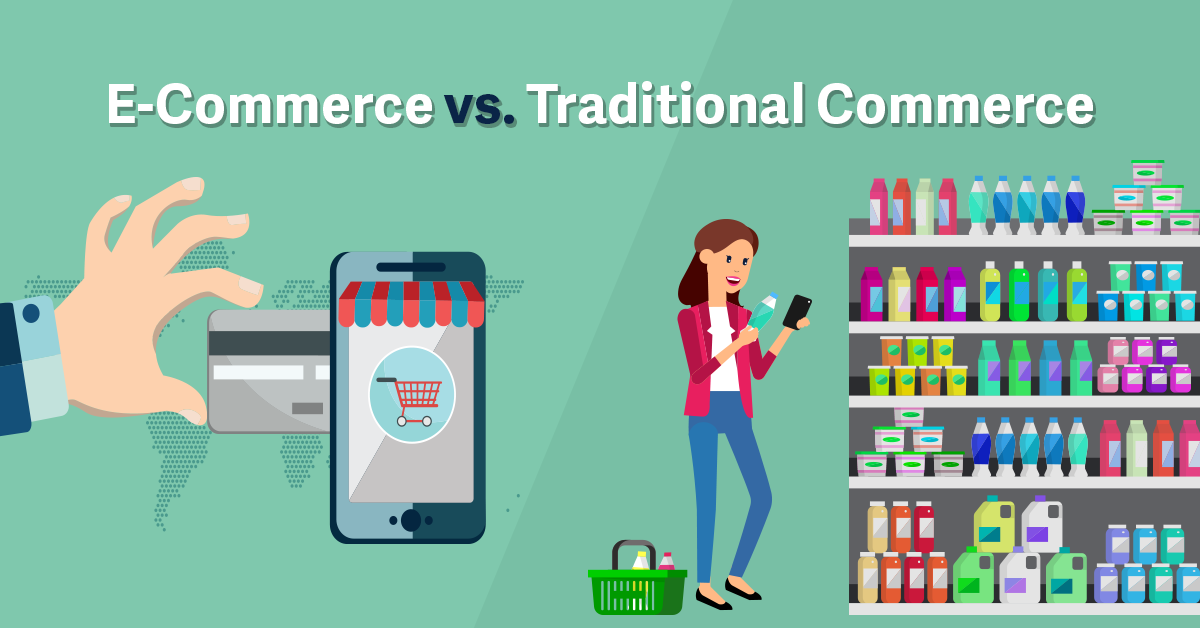Difference Between Traditional Commerce and E-commerce

Difference Between Traditional Commerce And E-commerce
Following are the differences between Traditional Commerce and E-commerce:
| Traditional Commerce | E-commerce |
| 1. Traditional commerce involves a great number of processes in addition to buying and selling transaction such as information exchange, identification of items or services, buying, customer support, marketing feedback, manufacturing of new products and their distribution. |
1. E-commerce is the buying and selling of goods and services, or the transmitting of fund or data, over an electronic network, primarily the Internet. It is a system that combines the resources of information system with the network connectivity to directly link the key business constituents customers and businesses.
|
| 2. Traditional commerce is based around face-to-face interaction. The customer has a chance to ask question and the sales staff can work with them to ensure a satisfactory transaction. | 2 . E-commerce doesn’t offer the benefit of face-to-face interaction unless live chats are implemented between the business and the consumer is usually screen-to-face. |
|
3. In traditional commerce, cost has to be incurred for the role of middlemen to sell the products.
|
3. E-commerce is very cost effective. The total cost required to run an e-business comparatively less. |
|
4. It is not easy to expand business, since business organization will have to incur a lot of expenses to expand the business.
|
4. In e-commerce, it is easy to expand the size of market from regional to international.
|
| 5. It takes a lot of time to complete a transaction in the traditional commerce. | 5. It saves a lot of time for both the consumers and the business firm. |
| 6. In traditional commerce, it is possible to physically inspect the goods before purchase. | 6. In e-commerce, physical inspection of goods before purchased not possible. |
| 7. Traditional business is open only for a limited time. Thus, it has time limitation. |
7. E-business is possible round the clock i.e. 24 x 7 service is possible. Thus, it has no time limitation . |
| 8. It takes a lot of time and money to introduce a new product and analyze the response of the customers. | 8. It is easy to introduce a product on the website and get the immediate feedback from the customers. |
| 9. It takes a lot of time complete a transaction in traditional commerce. | 9. It saves a lot of valuable time for both the consumers and the business firm. |
| 10. Communication or transactions are done in synchronous way. Manual intervention is required for each communication or transaction. |
10. Communication or transaction can be done in asynchronous way. Electronics system automatically handle when to pass communication to required person or do the transactions. |
| 11. It is difficult to establish & maintain standard practices in traditional commerce. |
11. A uniform strategy can be easily established and maintained in e-commerce.
|
| 12. Communications of business depends upon individual skills. | 12. In E-commerce or Electronic Market, there is no human intervention. |
| 13. There is manual processing of business transactions in traditional commerce. Thus, clerical errors may occur. | 13. There is an automated processing of business transactions in e-commerce. Clerical errors are minimized. |
| 14. Unavailability of a uniform platform as traditional commerce depends heavily on personal communication. | 14. E-commerce website provides user a platform where all information is available at one place. |
| 15. No uniform platform for information sharing as it depends heavily on personal communication. | 15. E-commerce provides a universal platform to support commercial / business activities across the globe. |
| 16. This can prove invaluable for small business owners who don’t have the startup capital to rent prime retail space and staff it to be able to sell their goods. | 16. E-commerce is usually much cheaper than maintaining a physical store in an equally popular location. Opening an online store is much easier. |
| 17. In traditional commerce, you are restricted to people who actually come to your shop. | 17. With e-commerce, you can do business with anybody living on a country you are able and willing to send mail to. |
| 18. A traditional commerce store has capability limits. Stocks are also limited. | 18. An online store has no capability limits, and you can have as many clients as your stock can serve. |
| 19. In a traditional store, the customer will be able to touch and check the items, to make sure they are suitable, and even try them on, which reduces the number of returned items or complaints. | 19. In an e-commerce store, significantly higher rate of returns are expected, as many will just order ad try the items at home, and won’t hesitate to return them if they don’t find the items suitable. |



